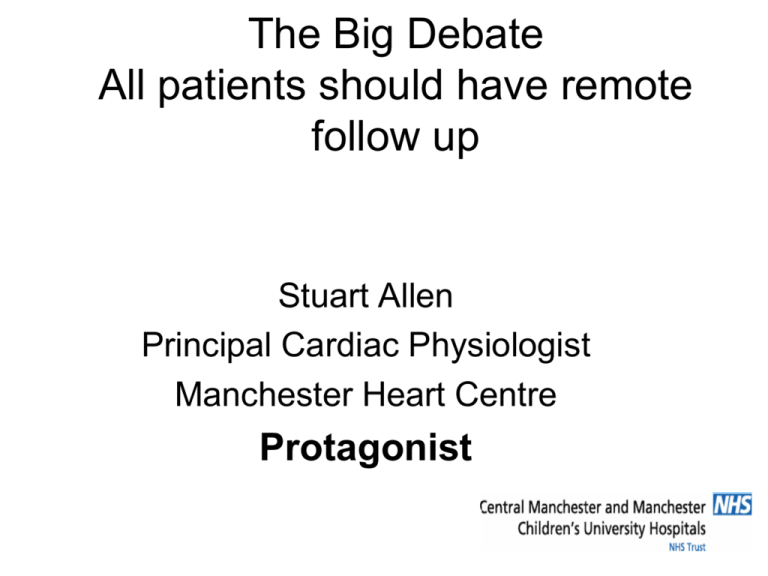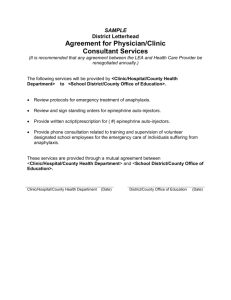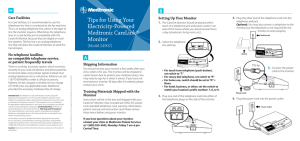S Allen - Heart Rhythm Congress
advertisement

The Big Debate All patients should have remote follow up Stuart Allen Principal Cardiac Physiologist Manchester Heart Centre Protagonist Why I might lose this debate • Cost of remote FU • Is the need for remote follow up exaggerated? • Traditional view of ‘in clinic follow up’. it works why change it? • Physiologists love change! • Is it threat to the physiologists role? It isn’t remote monitoring It’s remote management Remote Patient Management : Vision From Remote Device Monitoring to Remote Patient Management MORE CONTROL. LESS RISK Economic & Remote Programming and Complete Remote Patient Management Clinical VALUE Disease Management (Disease Alerts: HF, Ischemia...) Remote Monitoring (Cellular adapter) Remote Monitoring (System Integrity Alerts, Land line) Remote FU Remote Device Monitoring Remote Patient Management TIME The number of implants is increasing *Including Austria, Belgium, Switzerland, Denmark, Finland, France, Germany, Ireland, Italy, Netherlands, Norway, Portugal, Spain, Sweden and the UK. **Adapted from Eucomed 1 and Stoepel C et al. (2009)2. 1 Eucomed. Available at: http://www.eucomed.be. Accessed: 2010. 2 Stoepel C et al. Telemed J E Health 2009;15(10):1026–30 Increased use of devices creates a significant growth in demand for device follow-up resources Growth: 140% (year 2000-2005)- actual 160% (year 2005-2010) - estimated 600,000 500,000 400,000 Total Implants 300,000 Total Followup 200,000 100,000 1990 1991 1992 1993 1994 1995 1996 1997 1998 1999 2000 2001 2002 2003 2004 2005 2006 2007 2008 2009 2010 Economic modelling based on CCAD data NICE recommendations are 5 FU per year – model based on 1.3 pacemaker FU and 3 ICD / CRT FU. Total Enrolment Remote follow up today…. 800 700 600 500 400 300 200 100 0 • • • • Approx 50% centres < 50 patients enrolled Approx 10-15% centres >250 patients Majority 50-250 patients > 250 patients -where the pain comes! Miss Geraldine Mcparland has reported “phenomenal” results in terms of time saved with Medtronics’ CareLink system • • • – 185 pt transmission were assessed in 15.4 hrs = 2 working day – Without CareLink these pt checks would have taken 77 hours = 11 working days – Hospital staff working days saved = 9 Money Saved – €1,188 ambulance and other transport fees were avoided – 11% of patients avoided having to take time of work – 2 hospital admissions were avoided – CareLink reduced the overall burden of follow up care Over 97% of patient preferred the Medtronic CareLink system 100% of patients and carers found the system easy to use Publication The Irish Times -2008 Many remote FU trials Potential Role of remote FU Relevant Findings During ICD Follow-up Visits • Scheduled Unscheduled •None •ICD intervention appropriate ICD intervention inappropriate Arrhythmia without ICD therapy •Device related Battery depletion (ERI) Excessive charge time Shock impedance rise Pacing lead problem: pacing ± sensing ± impedance •Clinical Heart failure Angina pectoris Other clinical findings n = 1530 78.2% 4.4% 1.6% 3.3% (1197) (68) (25) (50) n = 175 19.4% 38.6% 19.4% 9.1% (34) (68) (34) (16) 1.0% 0.5% 0.0% (15) (8) (0) 0.6% 0.0% 0.6% (1) (0) (1) 0.7% (10) 0.0% (0) 2.7% 0.4% 6.7% (41) (6) (102) 2.3% 1.1% 8.6% (4) (2) (15) Heidbüchel H et al. Europace 2008; 10:351-7 In clinic follow up • 55% - 75% - no programming changes • The traditional device clinic needs to change • Future -Less device clinics more Arrhythmia and HF clinics • Physiologist lead – state registration will mean we can take a lead in disease management Current need • • • • More device trained staff More rooms More TIME New Heart Rhythm UK standards – In clinic follow up time recommended 30 to 45 mins – not just device check! • With ever increasing diagnostics available we need to do something different! today • • • • • ICD’s CRT-D CRT-P Pacemakers ILR’s can we manage these patients differently? Current devices • ICD’s – all the studies show that remote follow up can reduce unnecessary clinic visits – phantom shocks, single therapies • CRT – heart failure diagnostics • Pacemakers – problems are rare but lead complications can be life threatening. AF diagnostics – why shouldn’t we treat these patients earlier? • Ever increasing sensors and diagnostics especially HF – including pacemakers • ILR’s - And When the Patient Leaves the Clinic… • Identifying asymptomatic AF may be difficult due to infrequent office visits • Automatic AF alerts via Merlin@Home® transmitter and Merlin.net PCN can provide an opportunity for early intervention and anticoagulation • Early intervention can potentially reduce stroke risk Scheduled Follow-up Wk1 Wk2 Patient without Remote Monitoring Patient with Remote Monitoring New onset asymptomatic AF Wk3 Wk4 Wk5 Wk 6 Wk 7 Wk 8 Wk 9 Scheduled Follow-up Wk 10 Wk 11 Patient potentially at increased stroke risk for nine weeks Alerted next day with daily monitoring. Patient treated as deemed appropriate by physician Wk 12 High Incidence of AF in Device Patients 1 mode switch episodes. Heart Rhythm 2007; 4 (5S):S129-30. NSVT 0.8 0.7 AFib 0.6 0.5 0.0 CHARM Preserved clinical trial. CTOPP, MOST UKPACE clinical trials. 3 SOLVD clinical trial. 4 Augostini RS et al. A novel lead design reduces far field R-waves (FFRWS) and decreases the incidence of inappropriate automatic 2 VF VTsust 0.9 Events Free • 40% of patients with heart failure1 and 10-30% of those with bradycardia2 and tachycardia3 have atrial fibrillation (AF) • 27% of acute MI (myocardial infarction) patients had new onset of AF in one year4 1.0 0 200 400 600 Time (days) 27% of acute MI patients had a new onset of AF in one year 800 Which Patients are Affected by AF? Prevalence of AF increases with age in both men and women. Go AS, Hylek EM, Phillips KA, et al. Prevalence of diagnosed atrial fibrillation in adults. JAMA. 2001; 285:2370-2375. Manchester Heart Centre Sept 2012 • Device population 4000+ - 1108 patients on remote follow up - 133 ICD’s - 368 CRT-D’s - 147 CRT -P - 190 ILR’s - 270 pacemakers Carelink. Merlin, Cardio messenger and Latitude The next challenge • Looking at different models of ‘remote follow up • Cost - particularly with brady • Patient access Remote management • Empowers patients • Doesn’t have to be costly – walk in centres, GP surgeries, pharmacies, Tesco etc • The technology bus is arriving and we need to be driver! “Unpaired” Mode Merlin@home® Shortens time to interrogation, enables faster clinical decisions Interrogation on site w/out programmer: Emergency Department, Device Clinic, Remote Dispensary etc. Merlin.net® PCN ISO 27001 Fax Report Email Report 128 Bit SSL Encryption Report contains: Fastpath™ summary Episodes summary Most recent VT/VF episode + SEGM Diagnostics summary Parameters summary Reports can be emailed to designated person(s) for remote consultation Transmission to Merlin.net Inductive “Unpaired” M@h located at the site: Capable of interrogating any SJM CRM device compatible with Merlin@home – Accent/Anthem, Epic/Atlas, Current/Promote, Unify/Fortify, Ellipse/Assura 24 Mobile DirectAlerts Transmission also sent to home EP clinic* (if patient is enrolled in Merlin.net). Alerts can be delivered via Mobile DirectAlerts® *Transmission appears as patient initiated on recent transmissions page. Additional note in the ‘Alerts Summary’ Report In hospital remote follow up • CCU – • A&E - analysis of syncope, device therapies • In clinic – patients wont have to wait CareLink Express™ Connected Care Solution The CareLink ExpressTM Solution Carelink Express • • • • Pilot studies are near completion Looking at streamlining in clinic follow up Patients download and go home Triage – arrhythmias, HF and device issues CareLink Express™ Designs • Pilot studies are near completion • Looking at streamlining in clinic follow up • Patients download and go home • ?Triage – arrhythmias, HF and device issues www.eetimes.com/ gizmodo.com electronics-news/4229302/Plessey-samples-electric-potenti al-sens or /5119681/totos-intelligence-toilet-ii-smartl y-meas ures-the-tempe rature-of-your-pee-among-ot her-things stroke avoided your doctor alerted Sensor detects changes in electric field through clothing and through walls for www2.electronicproducts.com/E ECG monitor. siliconsouthwest.co.uk/index.php/2011/06/plessey-launches-first-electric-potential-sensor-chip/ The EPIC series sensors are the first to measure changes in an electric field much as a magnetometer detects changes in a magnetic field, requiring no physical or resistive contact to take readings. Medical devices that are simply held close to a patient’s chest, without wetting or shaving off hair, to obtain a detailed ECG. Driven Right Leg circuit This video is a practical demonstration of the automotive application for non-contact ECG measurements, through clothing in the difficult environment of a car. www.plesseysemiconductors.com/products/epic/videos/ EPIC Technical Details www.plesseysemiconductors.com/products/epic/technical/ The release of EPIC technology into the wider commercial environment has been talked about as being disruptive. The technology is certainly novel in its operation and opens up a wide range of fields. Conclusions • All device patients WILL have remote follow up • AF + HF management protocols needed • Remote follow up still needs significant staff resources • The way Physiologists work will change • Don’t do a debate after the gala dinner!! Thank you






